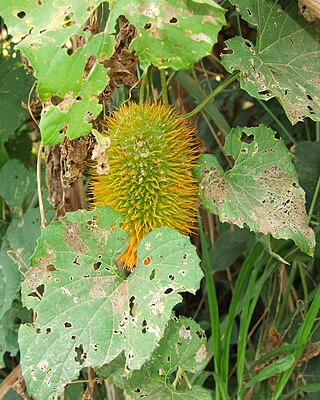Related Research Articles

Momordica charantia is a tropical and subtropical vine of the family Cucurbitaceae, widely grown in Asia, Africa, and the Caribbean for its edible fruit. Its many varieties differ substantially in the shape and bitterness of the fruit.

Cucurbitacins are a class of biochemical compounds that some plants – notably members of the pumpkin and gourd family, Cucurbitaceae – produce and which function as a defense against herbivores. Cucurbitacins and their derivatives have also been found in many other plant families, in some mushrooms and even in some marine mollusks.

Extraction in chemistry is a separation process consisting of the separation of a substance from a matrix. The distribution of a solute between two phases is an equilibrium condition described by partition theory. This is based on exactly how the analyte moves from the initial solvent into the extracting solvent. The term washing may also be used to refer to an extraction in which impurities are extracted from the solvent containing the desired compound.

Momordicin I, or 3,7,23-trihydroxycucurbitan-5,24-dien-19-al, is a chemical compound found in the leaves of the bitter melon vine, possibly responsible for its reputed medicinal properties.

Momordicin-28 or 13-hydroxy-28-methoxy-urs-11-en-3-one is a triterpene compound with formula C
31H
50O
3 found in the fresh fruit of the bitter melon.

Momordicinin (13β,28-epoxy-urs-11-en-3-one) is chemical compound, a triterpene with formula C
30H
46O
2, found in the fresh fruit of the bitter melon.

Momordicilin or 24-[1′-hydroxy,1′-methyl-2′-pentenyloxyl]-ursan-3-one is a chemical compound, a triterpenoid with formula C
36H
60O
3, found in the fresh fruit of the bitter melon.

Momordenol (3β-hydroxy-stigmasta-5,14-dien-16-one) is a natural chemical compound, a sterol found in the fresh fruit of the bitter melon.

Momordol or 1-hydroxy-1,2-dimethyl-2-[8′,10′-dihydroxy-4′,7′-dimethyl-11′-hydroxy methyl-trideca]-3-ethyl-cyclohex-5-en-4-one is a chemical compound with formula C
26H
48O
5, found in the fresh fruit of the bitter melon.
Charantoside is any of several related cucurbitane triterpenoid glycosides found in the fruits bitter melon vine. They include:
Goyaglycoside is any of several related triterpenoid glycosides found in the fruits bitter melon vine, called goya in Okinawan language. They include:

15,16-Dihydroxy-α-eleostearic acid, or 15,16-Dihydroxy-(9Z,11E,13E)-9,11,13-octadecatrienoic acid, is an organic compound with formula C
18H
30O
4, or H3C-CH2-(-CH(OH)-)2(-CH=CH-)3-(-CH2-)7-(C=O)OH. It can be seen as derived from α-eleostearic acid by the replacement of two hydrogen atoms by two hydroxyl (OH) groups.

Momordica foetida is a perennial climbing vine native of tropical Africa, closely related to the bitter melon and balsam apple. Its species name ("bad-smelling") refers to its unpleasant smell. It was previously named M. morkorra and M. cordata (Cogn.)

Momordica cymbalaria is a vine of the genus Momordica found in the Indian states of Andhra Pradesh, Karnataka, Madhya Pradesh, Maharashtra, and Tamil Nadu. It is a relative of the bitter melon plant. The plant has also been named Luffa tuberosa (Roxb.) or Momordica tuberosa (Roxb.)

Momordin or α-momorcharin is one of several related proteins isolated from several plants of the genus Momordica, which includes the bitter melon and the balsam apple.

Cucurbitane is a class of tetracyclic chemical compounds with formula C
30H
54. It is a polycyclic hydrocarbon, specifically triterpene. It is also an isomer of lanostane, from which it differs by the formal shift of a methyl group from the 10 to the 9β position in the standard steroid numbering scheme.
A kuguaglycoside is one of several chemical compounds isolated from the roots of the bitter melon vine by J.-C. Chen and others.
A kuguacin is one of several chemical compounds isolated from the bitter melon vine by J.-C. Chen and others.

Neokuguaglucoside is a chemical compound with formula C
42H
66O
14, isolated from the fruit of the bitter melon vine, where it occurs at 23 mg/35 kg. It is a triterpene glucoside with the cucurbitane skeleton. It is a white powder, soluble in methanol and butanol.
Concrete, in perfumery, is a waxy mass obtained by solvent extraction of fresh plant material. It is usually used for the production of absolutes.
References
- 1 2 M. M. Lolitkar and M. R. Rajarama Rao (1962). "Note on a Hypoglycaemic Principle Isolated from the fruits of Momordica charantia". Journal of the University of Bombay. 29: 223–224.
- ↑ Raman, A.; Lau, C. (1996). "Anti-diabetic properties and phytochemistry of Momordica charantia L. (Cucurbitaceae)". Phytomedicine. 2 (4): 349–62. doi:10.1016/S0944-7113(96)80080-8. PMID 23194773.
- 1 2 Olaniyi, A. A. (1975). "A neutral constituent of Momordica foetida". Lloydia. 38 (4): 361–362. PMID 1186439.
- ↑ Pitipanapong, J.; Chitprasert, S.; Goto, M.; Jiratchariyakul, W.; Sasaki, M.; Shotipruk, A. (2007). "New approach for extraction of charantin from Momordica charantia with pressurized liquid extraction". Separation and Purification Technology. 52 (3): 416. doi:10.1016/j.seppur.2005.11.037.
- ↑ Parkash, A.; Ng, T. B.; Tso, W. W. (2002). "Purification and characterization of charantin, a napin-like ribosome-inactivating peptide from bitter gourd (Momordica charantia) seeds". The Journal of Peptide Research. 59 (5): 197–202. doi: 10.1034/j.1399-3011.2002.00978.x . PMID 11966976.